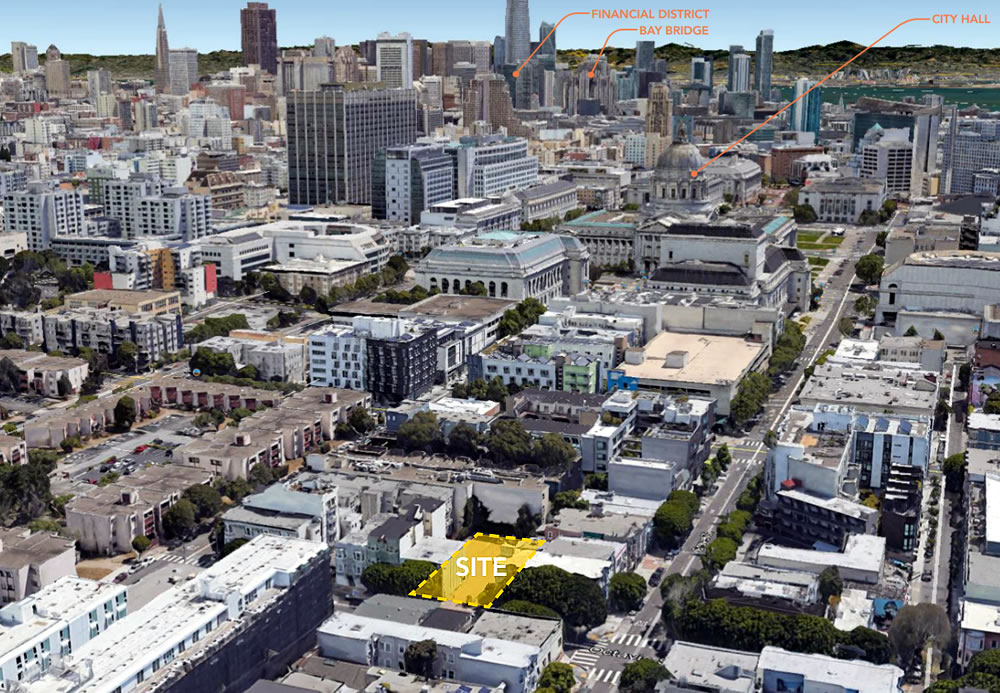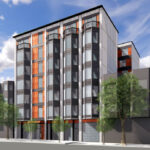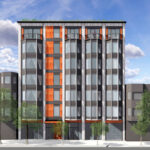Plans for a supersized building to rise across the two Hayes Valley parcels at 618-630 Octavia Street have been in the works since 2019, as we first reported at the time.
Since redesigned and then further refined by Handel Architects to yield 40 condos, a mix of 12 one-bedrooms, 27 twos and one three in an 8-story building that would rise up to 85 feet in height on the site, with a setback top floor and a rooftop terrace for the building’s residents, the proposed development could be approved/entitled by San Francisco’s Planning Commission next week.
In addition to the 20 off-street parking spaces that San Francisco’s Planning Code unconditionally allows for the 40 units as proposed, the project team is seeking authorization to include an additional 10 parking spaces in the building’s stacked garage, for a total of 30 off-street spots, noting that “the slight construction cost increase [for the additional 10 parking spaces] is outweighed significantly by the revenue generated from the sale of the additional parking spaces” and is “essential to making the project viable, especially in this day and age with all-time high construction costs and a volatile real estate market.”
From the project team:
The fact is that larger units without parking are more difficult to sell. This means that the units are more likely to be vacant longer, which increases the project’s carrying costs, decreases the ability to provide for affordable units and affordable housing costs. The granting of the parking concession is anticipated to make the market rate units more sellable and to decrease their marketing time, thereby resulting in actual cost savings to the construction of the units.
And in addition to yielding an estimated $1.2 million in additional revenue, which would cost $231,875 to produce, the project team notes that larger units without parking are typically worth “15-20 percent less” than comparable units with parking, despite the popular notion that demand for residential parking in San Francisco has dropped.



I like how they omitted a column of bays on the left…thus avoiding perfect symmetry, and offering a subtle comment on the imperfection of the human race, and a coy protest of the tyranny of SB9.
Or maybe the copy/past function just got stuck
most likely that column is the stairwell.
Love the rendered hanging interior blinds…
If I were a planning commissioner, I would hammer them on the details about the modeling they did to come to the conclusion that more parking would decrease time on market when it came time to consider this. Not that I disagree with it.
If they have actual data to back this up, as opposed to unsupported projections, it would be a game changer in the tired debates we have around here with urbanist utopians who believe that everyone will use public transit if we just make finding parking hard enough and enable us to shut them up for good.
The conclusion was supported by testimony from the President of Vanguard Properties, as excerpted below:
We would of course quibble with the conclusion that the slow absorption of the aforementioned luxury 8-unit project “is largely due to the fact that they do not come with parking and are located in a very dense urban location,” versus market conditions in general, with the pace of sales having dropped, inventory up and price reductions on the rise.
How? I mean, you would quibble so, because that’s your schtick. All of your hyperlink quibbles can be quelled by the fact that spring 2021 was the outlier of the past 6 years or so, omitting 2020’s black swan anomaly.
Perhaps you missed it in your rush to denigrate, but it’s not simply a matter of year-over-year trends, as linked above. In fact, a few of the linked headers might have offered some subtle clues, such as “Number of Homes for Sale in S.F. Hits an 11-Year Seasonal High” or “Pace of Home Sales in San Francisco Slips.” Which brings us back to the rationalization for increasing the number of off-street parking spaces for this and other new developments.
President of Vanguard Properties is correct. I have two young kids. I would never nor could I ever live somewhere in SF without parking. SF politicians have been promising improved transit infrastructure for decades in exchange for massive development and density. We just choke down more traffic and pollution while receiving effectively no new transit. That needs to change.
It’s BS from both sides. From the parking advocates – this is pretty lame attempt to justify additional parking. From transit advocates – wise up and look at the crap transit service the city offers. No wonder people want to drive.
How many people [on] this site actually take Muni regularly? Sure there are screwups and baffling lapses in service. However, people who ride it regularly figure it out and it generally works–my daughter relies on it to get to high school everyday. It’s never going to be as “convenient” as jumping in your car, but a little sacrifice in convenience is warranted given our pressing need to decarbonize our lives. Real Estate people who complain about having to wait a little longer to sell units without parking is another inconvenience that I think we can tolerate.
What the anti-car folks either don’t get or won’t acknowledge is even when transit has occasional screwups or lapses in services it either forces you off transit or to waste a whole bunch of time when you need to actually be places on time (school, work, business meetings…)
If Muni works for you 90% of the time, that sounds great but you really can’t miss even 10% of your commitments in the real world. So if 8% of the time you hit a 45 min delay (and 2% of the time an absolute disaster) you end up having to add in at least a 45 min buffer for every single trip.
The retort is that cars break down too and there can be traffic jams. But while I don’t know the actual data, my reality is that the “failure rate” of car trips is pretty low. Low enough that its practical throw out the occasional excuse for being late.
Maybe if you have a straight shot on a light rail line you can make it work. But my experience is that that minute you add in a bus and/or a connection then you are done for if you actually need reliability and timeliness.
I think it’s less that the “failure rate” of cars is low, but that it’s socially acceptable to occasionally get stuck in traffic, in a way that it isn’t socially acceptable to get delayed on transit.
Stuck in traffic: no one’s fault, or the city’s fault, certainly not yours.
Delayed on transit: you should have chosen differently– why didn’t you drive?
Not to say that the city couldn’t run transit better, of course.
Not saying that I never hit traffic, but between some common sense of avoiding some areas during rush hour, knowing alternate routes and now with the help of google maps and the like providing travel time estimates informed by traffic data (and also alternate routing), I just find that I very rarely experience a large unexpected delay driving places.
Now when time isn’t a factor, that’s different. Ten minutes in traffic can be aggravating, even when google maps warns you ahead of time. 45 min waiting for a bus on a sunny day can be relaxing.
This is a circular relationship – transit sucks so people avoid using it which means it never gets any better. Increasing the cost of car ownership is a decent way to nudge people’s preferences.
I live a stones throw away from the N line and we have two cars. Most of my neighbors with 2+ kids also have two cars. One is complaining that they have “only” two cars as it is hard to pick up and take kids from different schools/activities and also go to work (nanny drives one car).
Thank you. Our family lives in the neighborhood and walk, bike, MUNI, and (gasp) drive. Once kids start school, all bets are off. You’re not going to have a kindergarten ride and transfer on MUNI to get to school.
I did this once. Our transfer point was in front of UC Hastings. A police officer shooed away some people actively smoking crack and told them to move away from the bus stop and admonished them for doing it in front of young children.
When they were in preschool, it was a straight shot on the 5 and we’d frequently take the bus home (it was crowded but fun… until I was pickpocketed).
The City should commission a study of actual vehicle ownership in all these developments with limited parking. But they won’t cuz they won’t like the results.
Truer words were never posted.
What type of questions would they ask? And why should the city ask / not like the results? They’d find that those who don’t have dedicated parking wish they did?
I’m asking a lot of questions not to dispute the suggestion, but to understand it.
I think the hypothesis is: limiting parking limits car ownership and it’s people without cars that buy/rent the units without parking. So three questions: 1. Do you have a car? 2. Did you buy/rent a unit with parking? 3. If you don’t have a car, did you have one before buying/renting a unit without parking?
What I mean is that the City should survey residents of these new developments to ascertain how many vehicles the residents own and where they park them. They could make it a more thorough survey and ask about ride-sharing, bikes/biking, MUNI, etc.
My primary suspicion is that they’ll find that the residents own and use far more vehicles than the developments provide, increasing the burden on neighborhood parking. I could, of course, be wrong.
If you unbundle parking, then the folks that don’t drive aren’t subsidizing the construction of said spaces and loss of revenue when not all are rented out. We could solve parking concerns by not having it be free anymore (where demand exceeds supply, or said another way, folks don’t have incentive to not sit there all day)
I was surveyed, via live interview, by the city after purchasing in a new development about my parking use. I was asked how often I used my car, transit and about the size of my household. The problem was that the city workers had completely pre-decided the outcome of the survey to recommend less parking in new construction regardless of my answers. As soon as I said that I used Muni sometimes, they literally said to me, ‘doesn’t need parking’ and marked up their clipboards. The problem is that I would never buy a unit in SF without parking, never. Even if I only drive once a month, I still want (and want to pay for) the option.
The developer’s argument isn’t based on data. He’s basically saying “Transit sucks so people won’t snap my units up at a premium price unless we provide more parking”. He’s pleading for an exception to increase his profits. Meanwhile this location has a walkscore of 99. Transit (or a car) won’t even be necessary for most trips.
How about earmarking a couple of spots for carshare instead?
To borrow from the President of Vanguard Properties: “dense urban location” = “vibrant” street scene = fenta death camp. Given the quality of life situation in many areas, I can guarantee you there are a lot of folks who look at this and don’t envision ever setting foot on the block. It’s a matter of hopping in the car parked inside the gated garage to pursue their business elsewhere, just like the suburbs.
Why would someone with that attitude buy in Hayes Valley?
This answers itself – why not?
Daniel – It is because there’s 99% of the Bay Area already supporting an automobile centered lifestyle. Why not choose a car oriented neighborhood instead? There’s a huge variety available.
Central SF is one of the few locations enabling residents to easily live car-free. Why spoil it just because a developer wants to increase profits or some buyers are inflexible? People deserve to have a choice.
America’s accumulated investment in car-dependent communities is coming back to bite us in many ways. We should preserve and increase places like Hayes Valley, not reduce them into fortified suburban enclaves.
The parking spaces would be unbundled, regardless, and remain unsold if people chose not to buy them and/or there wasn’t any demand.
I agree, if you wanted to live in a suburban car/home/yard bubble, you’re much better off going to the peninsula, East bay, or even west portal.
But HV is a great neighborhood. You can love the neighborhood and want to live there and engage with your neighbors and the stores and restaurants *and* want a car to take kids to school and activities and everything else.
Life is short, why spent 2 hours on lousy public transit to go where you want, when you can do it in a car in 20 min?
Because if everyone did it, it wouldn’t be 20 min, but an hour?
I mean, sure, it makes sense as an individual– the best form of transit is a private car in a city where very few people drive– but it makes no sense as a matter of public policy.
Gross. Handel needs to do another rev. It’s distractingly confused on more than a few aesthetic levels.
Also, supersized? Because combining two small lots?
On account of the density bonus and plans to build up to 85 feet in height on the site, which is double the 40-foot height limit as zoned.
Keep in mind that a “supersized” McDonald’s meal was less than 20 percent larger than a large.
The ask for additional parking by the development team is very disingenuous when you zoom out and look at the rest of the neighborhood where all of the new market-rate condos that have been built (& sold) have abided by the Market & Octavia Plan which sets parking maximums to .5 per unit.
What’s going on at Handel? The design work seems less than what it used to be… between this and 950 Gough… they were a good firm.
I hope this gets a further “refinement” or “redo”
UPDATE: The Planning Commission hearing to entitle the supersized development to rise at 618-630 Octavia Street, along with an additional 10 parking spots, has been pushed back another two weeks to April 28 at the earliest.
Why do so many of these new apartment blocks have an orange piece? Why not some other color? Or are all these architects Dutch and simply using the color of the reigning house?
I have wondered the same thing for years. Maybe you’re right about the Dutch. Was there an architecture book by a Dutch architect that laid out all the benefits of orange as an accent colour?